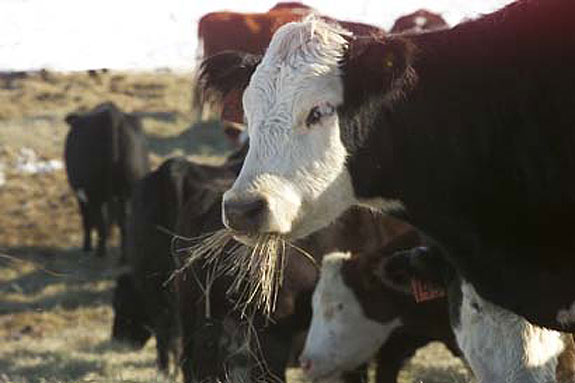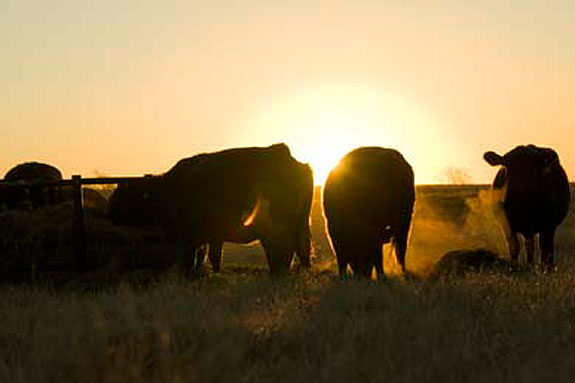“Lack of forage is hindering many a cattle operation, especially when combined with a regional shortage of hay with most of the hay being low-quality and expensive,” said Daren Redfearn, Oklahoma State University Cooperative Extension forage and pasture management specialist.
The forecast is for continued dry weather through October. If this is the case, it could be March before any appreciable forage can be grown for pasture.
“With hay feeding costs ranging from $2 to $3 per head per day, the potential cost of feeding a single animal through to March could be as great as $600,” Redfearn said. “There are few situations where feeding hay for this length of time is profitable.”From now through at least early November, it may be necessary to restrict animals to a central feeding location to allow the forage time to grow or the pastures to recover. This allows for both short-term and long-term pasture recovery. In order to do this, it is important to:
• Move animals to the worst pasture, using it as a sacrifice area
• Allow the better pastures an opportunity to recover
• Reduce the need to renovate a large number of acres
• Increase nutrient supply of low fertility soils
This situation raises the following question: What are the reasonable forage production options for the upcoming fall and spring?
Mark Gregory, OSU Cooperative Extension area agronomy specialist, said currently the best options are those that have been successful in most years for fall, winter and spring forage production.
“Depending on a producer’s location in the state, there are several choices to consider; although these are the most reasonable options, they are also highly risky because of the current lack of soil moisture,” he said. “When possible, choosing at least two of the options would increase the probability of successful fall and winter pasture production.”
For bermudagrass pastures, Gregory said the key point to remember is that a modest level of soil fertility is needed to increase the probability of bermudagrass regrowth occurring this fall when precipitation occurs.
“A modest fertility level will also support earlier recovery for bermudagrass pasture production next spring,” he said.
Bermudagrass pastures that are dormant and grazed short will take some time and moisture to recover. Most bermudagrass pastures will begin to show signs of regrowth with as little as 1/3 inch to 1/2 inch of rain. However, additional precipitation will be necessary for adequate forage production.
“Most bermudagrass pastures will need at least 1.5 inches of precipitation to recover enough to begin grazing and 5 inches to 6 inches of precipitation so that forage growth can continue through until first frost,” Redfearn said.
Ideally, the precipitation should be slow enough that it results in minimal runoff. The fall growth potential depends on the timing and amount of rainfall.
With many bermudagrass pastures grazed short, the opportunity to successfully sod-seed small grains or legumes – where adapted – also is an option.
“Most of the seeding failures of small grains and legumes occur as a result of too much warm-season grass competition,” Redfearn said. “In many areas, traditional wheat pasture will offer the most reasonable option for fall forage production. However, in some instances, planting one of the other small grain crops could be an option to increase the forage production potential.”
Additional information about this management tool is available through OSU Cooperative Extension Fact Sheet PSS-2701, “Sod-Seeding Small Grains into Bermudagrass Pasture,” available athttp://osufacts.okstate.eduvia the Internet.

“In addition to wheat pasture, including oat in a winter annual pasture mixture at a third to half the weight of the blend would improve the potential to produce adequate fall forage,” Redfearn said. “Including cereal rye also would improve the chance of producing winter pasture.”
For those who may want to consider including annual ryegrass in the mixture, be aware that it will not provide adequate fall forage most years but will produce more reliable pasture in the spring.
“Where legumes have been productive in past years, a blend of white clover, arrowleaf clover and red clover should be considered to shorten winter hay feeding,” Gregory said. “If clover has desirable establishment, these pastures should not be grazed until late March at the earliest.”
Gregory and Redfearn said some producers may benefit from fertilizing bermudagrass or tall fescue pastures with 50 pounds to 60 pounds of nitrogen per acre in late August, which could result in available pasture by early December.
Additional information about this option is available through OSU Cooperative Extension Fact Sheet ANSI-3035, “Managing Bermudagrass Pasture to Reduce Winter Hay Feeding in Beef Cattle Operations,” available athttp://osufacts.okstate.eduvia the Internet.
All of the winter annual forage grasses, including small grains and annual ryegrass, are relatively easy to plant in many areas. If seed is broadcast, dragging the pasture with a harrow or lightly disking will increase the chance of success. Using a drill also will increase the likelihood of establishing a solid stand.
“After establishment, applying 50 pounds to 60 pounds of nitrogen per acre or 120 pounds of urea (46-0-0) per acre in February will increase the chance of providing needed forage from mid March to June,” Redfearn said. “Where legumes are adapted, including white clover, red clover and arrowleaf clover will lessen the forage production risks.”
However, both Redfearn and Gregory caution that producers need the skies to open and rain to fall regardless of the forage production option selected.
“Soil moisture is more or less depleted in most areas, so we will need about 5 inches to 6 inches to produce 1 ton of forage,” Redfearn said.
“This moisture will need to fall in at least two events for the perennial pasture options and probably three events for the annual pasture options.”
If soil phosphorus and potassium are adequate, then applying a small amount of nitrogen to bermudagrass should take advantage of any late summer precipitation.
“Again, moisture is needed, but this can take advantage of a single precipitation event better than the annual forage options,” Gregory said. FG
—Source: Oklahoma State University Cooperative Extension website
Photos courtesy of Oklahoma State University Cooperative Extension Service.









